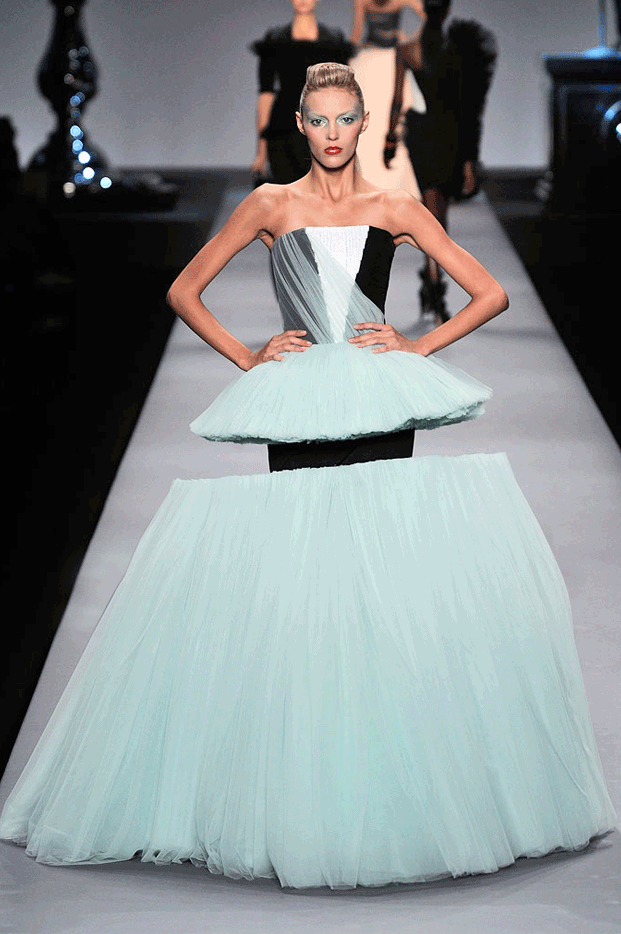Fashion
responds and directs attitudes to distinguish whether something is viewed as
tasteful normally by the trickle-down effect which is when the upper class
start wearing something which is deemed as tasteful, which then trickles down
to readymade copies by middle and working class so they can copy what is of
good taste but by the time it reaches lower class it is no longer deemed of
good taste and the whole cycle is thus repeated.
"Fashion
is not properly a matter of taste (for it may be extremely antagonistic to
taste), but a matter of mere vanity in order to appear distinguished."
-Immanuel
Kant, Anthropology from a Pragmatic Point of View
Examples of fashion deemed as
being of good taste –
Chanel’s Little Black Dress.
Chanel’s Little Black Dress.
Launched
in 1926 it was nicknamed by American Vogue, ‘Chanel’s Ford dress,’ for being so
easily ready made by its simple design of high neckline, long fitted sleeves,
cut to above the knee and made with no adornment of frills or embroidery. It
was marketed as the uniform for the modern woman; it was launched at a time of
the Great depression so it was in fitting with the time and became a symbol of practical
chic. It was therefore deemed as being of good taste as was functional to the
period, Chanel has been reported of saying, ‘Really they are so badly dressed,
I will put them all in black to teach them good taste.’ What was once launched
as a practical example of clothing has been over time marketed to become an
indicator of elegant good taste.
Dior’s ‘New Look.’
In the
post war era of 1947 Dior aimed to capture the imagination and hope of women in
launching his ‘New Look’ which consisted of nipped in waists and billowing full
flowing skirts. It created instant attention due to its excess it became a symbol
of taste by its affiliation to the upper classes as they were the only ones
able to buy it and could not be instantly copied as fabric was still being
rationed therefore it was marked out as an inspirational look. It was marketed
as an antithesis to war time and inspired from women returning to more passive
roles in the home so it was shown as step away from utilitarian clothing and a
symbol of glamour and femininity. Dior was not alone in his venture it was a collaboration
between himself and Marcel Boussac who was also known as the ‘cotton king,’ therefore
by introducing a style deemed of being of good taste which used full billowing
skirts it was in favour of Boussac’s business of supplying fabric, therefore
promoting textile industry at the same time. The way it was marketed and distributed
only among the wealthy at first ensured it the stamp of being of good taste,
but in reality it was not in good taste of the time as it was a period when
rationing was still in place until 1953 so was insensitive to the needs of the
collective public, it was banned in Britain as was seen as symbol of
extravagance.
Calvin
Klein boxers.
The
launch of Calvin Klein boxers in 1982 transformed men’s underwear market,
previously just known as functional object almost over-night it was re-launched
as sought after fashion forward product. It was at a time in the eighties when
emergence of new man was becoming prominent in seeing not just women as objects
to be admired but men were being viewed as objects of admiration and in taking
pride of themselves. Calvin Klein’s were marketed by a sensual portrayal which
would appeal to men and women and were instantly sought after as symbols of fashionable
taste. They still are seen as indicators of good taste by their numerous celebratory
endorsements, how they are marketed and consumed by the public still relies
heavily on the symbol they represent of increased sexuality.
However nowadays
we no longer are so reliant on how something is marketed to be deemed as
tasteful, it has become more subjective by the dissolution of trickle-down
effect and by the emergence of mass media which enables word of mouth and online
consensus in favour of just the solely marketed image. We are wiser and open to
the impact of marketing, taste has become subjective.










